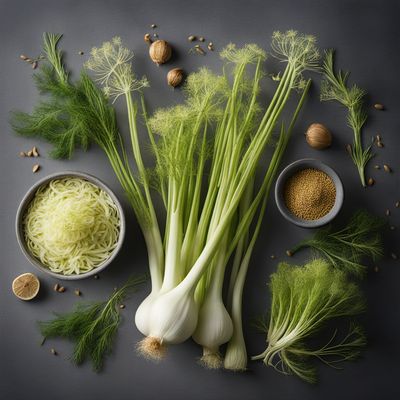
Ingredient
Florence fennels and similar-
The Delicate Delight: Unveiling the Versatility of Florence Fennel
Florence fennel is characterized by its bulbous shape, pale green or white color, and feathery fronds. The bulb has a crisp texture and a mild, slightly sweet flavor with hints of licorice. The stalks are similar in taste and texture to celery, while the fronds have a more pronounced anise-like flavor. When cooked, the bulb becomes tender and develops a subtle sweetness, making it a delightful addition to soups, stews, and roasted dishes. Raw, it adds a refreshing crunch to salads and slaws.
Origins and history
Florence fennel originated in the Mediterranean region and has been cultivated for centuries. It has a rich history in Italian cuisine, where it is commonly used in dishes such as salads, risottos, and pasta. The ancient Greeks and Romans also valued fennel for its medicinal properties and used it as a digestive aid. Today, it is widely grown in Europe, North America, and other parts of the world with suitable climates.
Nutritional information
Florence fennel is low in calories and a good source of dietary fiber, vitamin C, potassium, and folate. It also contains antioxidants and phytonutrients that contribute to its health benefits.
Allergens
Florence fennel is not commonly associated with allergies, but individuals with a known allergy to celery or other plants in the Apiaceae family may experience cross-reactivity.
How to select
When selecting Florence fennel, look for bulbs that are firm, smooth, and free from blemishes or signs of wilting. The stalks should be crisp and the fronds vibrant green. Avoid bulbs with brown spots or signs of mold. Smell the fennel to ensure it has a fresh, sweet aroma.
Storage recommendations
To maintain freshness, store unwashed Florence fennel bulbs in a plastic bag in the refrigerator's crisper drawer. It can last for up to a week. Remove the fronds before storing, as they tend to wilt quickly. Stalks and fronds can be stored separately in a container with water, similar to fresh herbs.
How to produce
Florence fennel can be grown in home gardens by sowing seeds directly in well-drained soil during the cooler months. It requires full sun and regular watering. Thin the seedlings to allow proper bulb development and harvest when the bulbs reach a desirable size.
Preparation tips
To prepare Florence fennel, trim off the stalks and fronds, reserving them for other uses. Cut the bulb in half lengthwise and remove the tough core. Thinly slice or chop the bulb for raw preparations or leave it whole for roasting or braising. The fronds can be used as a garnish or chopped and added to salads, dressings, or marinades. The stalks can be used as a flavoring agent in stocks or soups.
Substitutions
If Florence fennel is not available, you can substitute it with celery, celeriac, or bok choy for a similar crunch and mild flavor.
Culinary uses
Florence fennel is commonly used in Italian cuisine, where it is a key ingredient in dishes like Fennel and Orange Salad, Fennel Risotto, and Roasted Fennel with Parmesan. It can also be grilled, braised, or sautéed as a side dish or incorporated into pasta sauces, seafood dishes, and vegetable medleys.
Availability
Florence fennel is commonly available in Europe, North America, and other regions with a suitable climate for cultivation.
